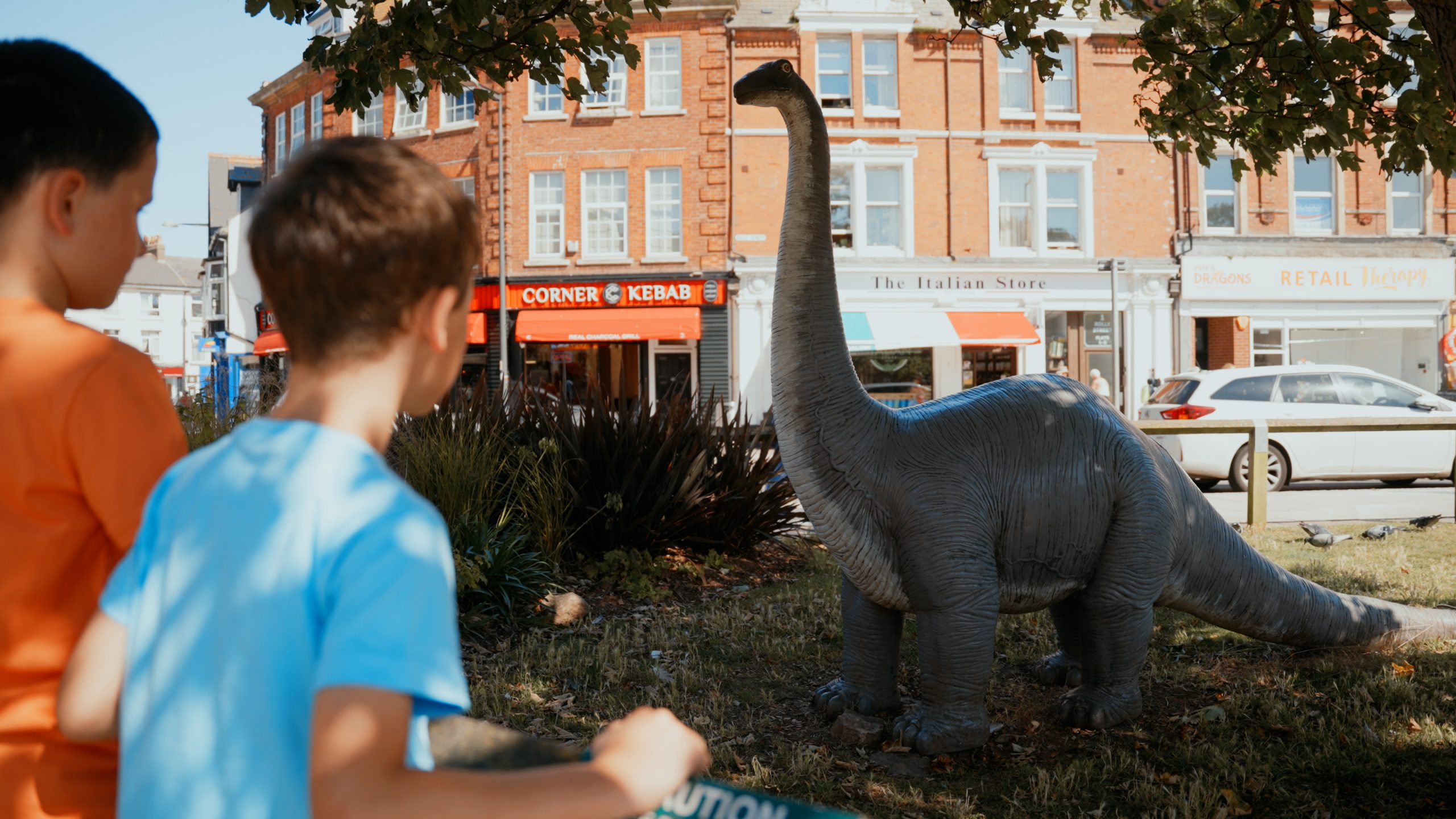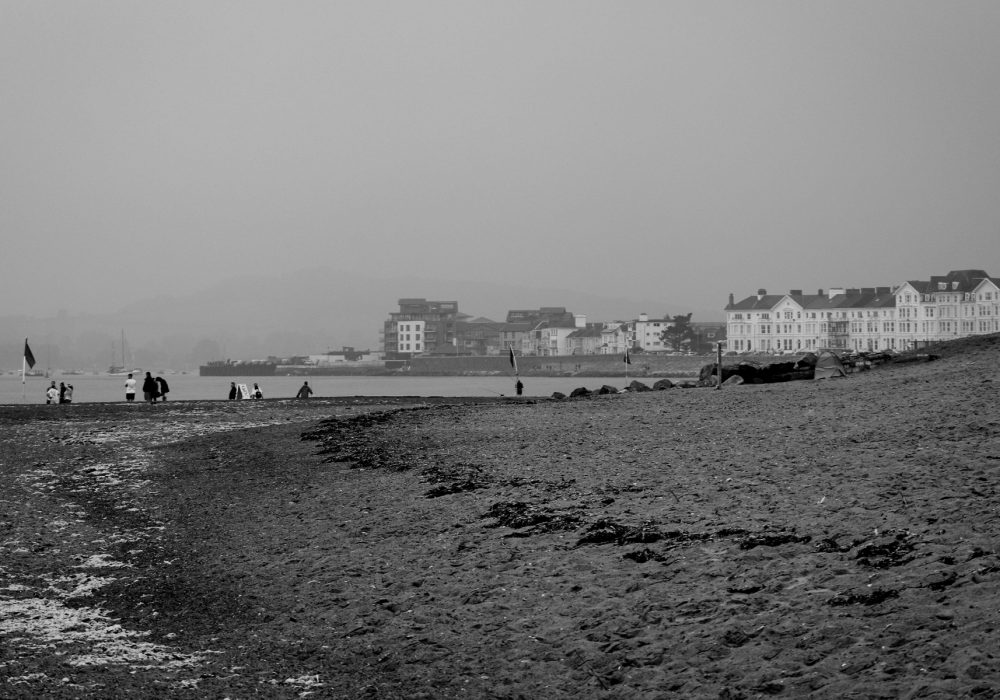Prehistoric Wonders: Triassic Age Coastline
The red rocks that make up Exmouth’s dramatic coastline have their origins going back for over a quarter of a billion years in time. Most are now considered to be of Triassic age, the earliest of these being some 252 million years old. It is possible to see the oldest ones in the sequence near Manor Park, just below The Beacon, as well as close to the water wheel at the start of the wooded walk behind the Pavilion & Ocean buildings that line the promenade.
These are deep red Breccias (angular rock fragments set in a finer red muddy matrix) which leads on to slightly younger mudstones & sandstones that are best seen at Orcombe Point and beyond at the end of Queen’s Drive. Why red you may ask? Well, at the time these rocks were formed Exmouth was near was just above the equator at the centre of a mega-desert that stretched on a huge single continent called Pangea, from what we now call Russia across to North America. These were hot, mostly dry oxidising climatic conditions that turned any iron in the sediments into a red rust that coated all of the grains & rock fragments. Similar desert conditions can be seen today in parts of central & Western Australia. Dinosaurs had not evolved at this time (although some other early & smaller reptiles had) so sadly no fossils of these magnificent creatures can be found in these red rocks.
Find out more about the Jurassic Coastline and prehistoric Exmouth by checking out the UNESCO Jurassic Coast World Heritage Site information boards at Orcombe Point.
After the Reptiles: Ice Age and Early Human Remnants
In addition to its Triassic heritage, Exmouth bears traces of the more recent Ice Age, which occurred approximately 2.6 million to 11,700 years ago. Glacial deposits, moraines, and erratic boulders provide evidence of past glaciation events that shaped the region’s topography.
While Exmouth’s prehistoric record primarily focuses on geological and paleontological aspects, evidence of human prehistory can also be found in the region. Archaeological sites and artefacts dating back to the Stone Age, Bronze Age, and Iron Age offer glimpses into the lifestyles, technologies and cultural practices of ancient human inhabitants.
The Roman Influence: A Legacy of Conquest
Exmouth’s location made it an attractive site for Roman settlement. The town lay near the mouth of the River Exe, providing access to the sea and serving as a gateway to inland regions.
The Romans constructed an extensive network of roads throughout Britain, including routes that passed through Exmouth. These roads facilitated trade, communication, and the movement of Roman troops, connecting Exmouth to other Roman settlements across the region.
While the exact extent of Roman fortifications in Exmouth is not fully known, it’s likely that the town had some form of defensive structures to protect against potential threats. Roman forts and watchtowers were typically constructed along strategic points of the coastline to guard against invasion and piracy.
Medieval Heritage: A Thriving Port
With the arrival of the medieval era, Exmouth grew as a thriving port town, its fortunes tied to maritime trade and fishing. As a coastal settlement, Exmouth relied heavily on maritime trade and fishing for its livelihood. The town’s strategic location along the Exe Estuary made it an ideal hub for shipping goods and catching fish, contributing to its economic prosperity.
The medieval period saw the construction of the St. Margaret & St. Andrew’s Church in Littleham, which served as the focal point of religious life in Exmouth. The church, with its imposing tower and Gothic architecture, provided a place of worship and community gathering for residents.
Naval History: Defending the Coast
During the Napoleonic Wars, Exmouth played a crucial role in defending Britain’s coastline from French invasion. With its harbour serving as a base for naval vessels, including warships and privateers, the town’s maritime infrastructure, including docks, shipyards and naval facilities, supported naval operations and the maintenance of Britain’s naval supremacy.
Privateering, the practice of privately owned ships authorized by the government to engage in naval warfare against enemy vessels, was prevalent during the Napoleonic Wars. Exmouth was home to several privateers who operated with government commissions to harass and disrupt French shipping in the English Channel.
Victorian Splendour: Seaside Resorts and Promenades
In the 19th century, Exmouth experienced a boom in tourism as seaside resorts became fashionable destinations for the affluent due to the introduction of the Great Western Railway.
Explore the elegant Georgian and Victorian architecture that adorns the town, and take a leisurely stroll along the Exmouth Seafront Promenade, which offers stunning views of the coastline. Visit the Exmouth Museum to delve into the town’s Victorian heyday and learn about its transformation into a popular seaside resort.
World War I & World War II: Defending the Home Front
Exmouth, like many towns across Britain, felt the impact of World War I and II, with its residents making sacrifices on the home front and its shores witnessing naval activity. The Exmouth War Memorial, located in the Strand, serves as a poignant reminder of the town’s contribution to the war effort and the lives lost.
Exmouth experienced air raids and bombing raids during World War II, as enemy aircraft targeted coastal towns and cities throughout Britain. The town’s civilian population endured the hardships of wartime rationing, blackout regulations, and the constant threat of air attacks.
Post-War Reconstruction: Returning to a Coastal Haven
Since World War II, Exmouth has undergone a transformation, rebuilding its infrastructure and economy while maintaining its coastal allure. The post-war period saw the town’s economy rebound with a focus on tourism, bolstered by its sandy beaches, scenic promenade and recreational activities. Modernisation efforts brought new housing developments, retailers and cultural venues, shaping Exmouth into a vibrant seaside resort with a diverse array of attractions and amenities.
Today, Exmouth stands as a dynamic coastal town; its natural heritage, including its coastline and wildlife habitats, is cherished and protected. With a thriving tourism sector, a commitment to sustainability, and a strong sense of community spirit, Exmouth looks towards the future while honouring its past.
And there we have it – a brief history of Exmouth! Of course there’s so much more to discover about the town’s past, but that’s best done by visiting!
If you’re thinking of visiting Exmouth be sure to check out our where to stay, food and drink, things to do and what’s on pages. We’d also love to see your Exmouth snaps so be sure to tag us in your posts using @VisitExmouth.
You can stay up to date with our latest blog posts, offers and more by signing up to our e-newsletter here. And, don’t forget to follow us on Facebook and Instagram.








